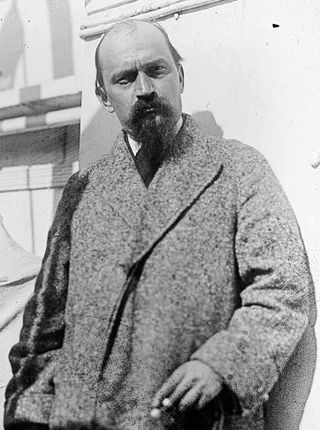
Ivan Meštrović was a Croatian and Yugoslav sculptor, architect, and writer. He was the most prominent modern Croatian sculptor and a leading artistic personality in contemporary Zagreb. He studied at Pavle Bilinić's Stone Workshop in Split and at the Academy of Fine Arts Vienna, where he was formed under the influence of the Secession. He traveled throughout Europe and studied the works of ancient and Renaissance masters, especially Michelangelo, and French sculptors Auguste Rodin, Antoine Bourdelle and Aristide Maillol. He was the initiator of the national-romantic group Medulić. During the First World War, he lived in emigration. After the war, he returned to Croatia and began a long and fruitful period of sculpture and pedagogical work. In 1942 he emigrated to Italy, in 1943 to Switzerland and in 1947 to the United States. He was a professor of sculpture at the Syracuse University and from 1955 at the University of Notre Dame in South Bend, Indiana.
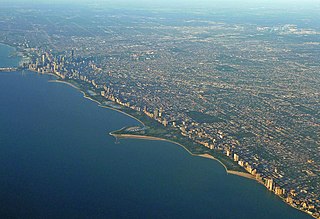
Lincoln Park is a 1,208-acre (489-hectare) park along Lake Michigan on the North Side of Chicago, Illinois. Named after US President Abraham Lincoln, it is the city's largest public park and stretches for seven miles (11 km) from Grand Avenue, on the south, to near Ardmore Avenue on the north, just north of the DuSable Lake Shore Drive terminus at Hollywood Avenue. Two museums and a zoo are located in the oldest part of the park between North Avenue and Diversey Parkway in the eponymous neighborhood. Further to the north, the park is characterized by parkland, beaches, recreational areas, nature reserves, and harbors. To the south, there is a more narrow strip of beaches east of Lake Shore Drive, almost to downtown. With 20 million visitors per year, Lincoln Park is the second-most-visited city park in the United States, behind Central Park.

Lorado Zadok Taft was an American sculptor, writer and educator. Part of the American Renaissance movement, his monumental pieces include, Fountain of Time, Spirit of the Great Lakes, and The Eternal Indian. His 1903 book, The History of American Sculpture, was the first survey of the subject and stood for decades as the standard reference. He has been credited with helping to advance the status of women as sculptors.

Toma Rosandić was a Serbian and Yugoslav sculptor, architect and fine arts pedagog. Together with Ivan Meštrović (1883–1962), he was the most prominent of Yugoslav sculptors of his day.
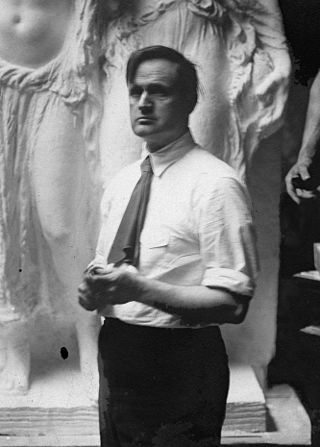
James Earle Fraser was an American sculptor during the first half of the 20th century. His work is integral to many of Washington, D.C.'s most iconic structures.

The history of sculpture in the United States begins in the 1600s "with the modest efforts of craftsmen who adorned gravestones, Bible boxes, and various utilitarian objects with simple low-relief decorations." American sculpture in its many forms, genres and guises has continuously contributed to the cultural landscape of world art into the 21st century.

Pobednik is a monument in the Upper Town of the Belgrade Fortress, built to commemorate Serbia's victory over the Ottoman and Austro-Hungarian empires during the Balkan Wars and the First World War. Cast in 1913, erected in 1928, and standing at 14 metres (46 ft) high, it is one of the most famous works of Ivan Meštrović. It is also one of the most visited tourist attractions in Belgrade and one of its most recognizable landmarks.

Angel of Grief or the Weeping Angel is an 1894 sculpture by William Wetmore Story for the grave of his wife Emelyn Story at the Protestant Cemetery in Rome. Its full title bestowed by the creator was The Angel of Grief Weeping Over the Dismantled Altar of Life.

Nellie Verne Walker, was an American sculptor best known for her statue of James Harlan formerly in the National Statuary Hall Collection in the United States Capitol, Washington D.C.
Benjamin Franklin Ferguson was an American lumber merchant and co-founder of the Santee River Cypress Lumber Company. The firm specialized in the harvesting of old-growth timber from the blackwater river bottomlands of central South Carolina, in and around the Santee River watershed. The tracts of land logged by Ferguson, in partnership with fellow logging executive Francis Beidler, included substantial tracts of valuable bald cypress.
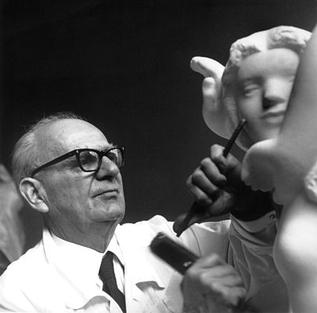
Frano Kršinić was a Croatian sculptor active in former Yugoslavia. Along with Ivan Meštrović and Antun Augustinčić, he is considered one of the three most important Croatian sculptors of the 20th century. His most widely known work is the statue of Nikola Tesla installed at the Niagara Falls State Park, United States, an identical copy of the monument residing in front of the building of the School of Electrical Engineering, University of Belgrade (Serbia).

Ivan Meštrović Gallery, is an art museum in Split, Croatia dedicated to the work of the 20th-century sculptor, Ivan Meštrović. The gallery preserves and presents to the public the most significant works of Meštrović, and is in itself an art monument. The permanent collection includes works of sculpture, drawings, design, furniture and architecture. Holdings include original plaster models by the artist, as well as finished works in bronze, marble and wood. The gallery building and grounds were based on original plans by Meštrović himself, and included living and working areas, as well as exhibition spaces.

Vojin Bakić was a prominent Yugoslav sculptor.

Immigrant Mother is a public artwork by Croatian artist Ivan Meštrović located in Cathedral Square Park in Milwaukee, Wisconsin, United States. The bronze sculpture sits on a red granite base and depicts a mother with her children.

St. Jerome the Priest is a bronze statue, by Ivan Meštrović, located at 2343 Massachusetts Avenue, Northwest, Washington, D.C.

Rudolf Matutinović was a Croatian sculptor.

The art of Yugoslavia is the visual art created by a number of painters, sculptors and graphics artists in Yugoslavia.

Christ and the Samaritan Woman is an outdoor sculpture by Croatian sculptor Ivan Meštrović. Created in 1957, the sculpture resides in front of O’Shaughnessy Hall on the campus of the University of Notre Dame as part of the Shaheen-Mestrovic Memorial, which was completed in 1985 by the Department of Landscape Architecture and Planning in the South Bend office of Cole Associates. The marble and bronze sculpture depicts the events in John 4, in which Jesus converses and evangelizes to a woman from Samaria, with whom the Jews would not normally associate. Eli J. Shaheen, a Notre Dame alum, was the donor for the project, which is owned by the university. The “Woman at the Well,” as it is often referred, is flanked by sculptures of the gospel writers Luke the Evangelist and John the Evangelist. It has been regarded as the most notable and celebrated of Meštrović's works from his period at Notre Dame.
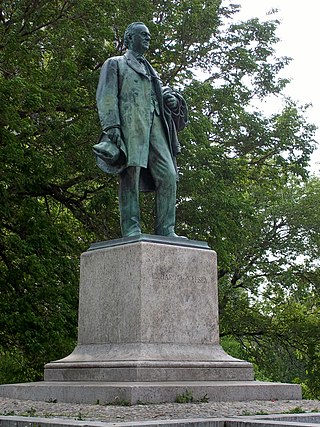
The Richard J. Oglesby statue is a monumental statue of Richard J. Oglesby in Chicago, Illinois, United States. Dedicated in 1919, the statue was designed by Leonard Crunelle and located in the city's Lincoln Park.

The Pietà is a marble statue by Croatian artist Ivan Meštrović housed in the Basilica of the Sacred Heart on the campus of the University of Notre Dame. It is considered one of his most celebrated works. Meštrović conceived the work while imprisoned in Zagreb by the Ustaše and then sculpted it in Rome from a six ton block of Carrara marble. It is hence also known as Roman Pieta. Meštrović also made several copies of the work which are now held at the Ivan Meštrović Gallery, Vatican Museums, and Pontifical Croatian College.






















